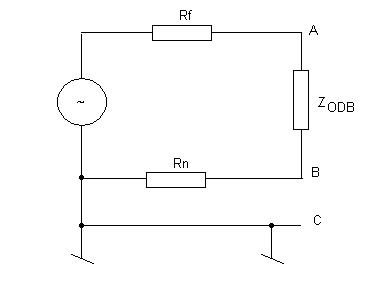BB95 wrote:
Quote: A potential difference is needed for the current to flow.
and that's how it really does it.
We consider the circuit in which we have:
1) power source - transformer
2) phase conductor resistance - wire resistance
3) receiver - also some resistance or impedance
4) resistance of the neutral conductor - wire resistance.

If current flows through the receiver, voltage drops occur on the resistances Rf, Z and Rn. Thus, at point A there is a potential higher than at point B. Since the resistances Rf and Rn are smaller than the impedance Z, the voltage drop at the receiver is also the greatest - almost an inch of the supply voltage.
Suppose that Rf and Rn have a resistance of about 1 Ohm (probable values) and that the Z of the receiver is a resistance (2kW heater) of about 26.5 Ohm. Power supply, of course, 230V; The current consumed is:
I = U / R where R is Rf + Z + Rn -> I = 230 / 28.5 = 8.07A
The voltage drop across Rf is:
Uf = I * Rf = 8.07V
For Rn we have the same, so the voltage drop across the receiver is:
Uz = 230-2 * 8.07 = 214V (almost).
This means that the potential of point A with respect to ground (ground) is 214 + 8.07 = 222.07V.
Point B has a potential to ground of 8.07V.
Assuming now that a 1000 Ohm resistance is connected between points B and C (human model), we get that as a result of the potential difference of these points, a current of the value:
I = U / R = 8.07 / 1000 = 8.07mA.
In such a situation, the RCD should not trip, because its activation threshold is about 50% of the rated value (if we have 30mA, the activation threshold is 15mA). If it works, it means that the resistance of the neutral wire is greater. Let's see that it is enough to increase the value of the resistance Rn twice, which is also not very improbable and we already have a potential of about 16V at point B with respect to ground. This will allow the current to activate the residual current device to flow.
So summing up:
The current flows through the neutral conductor during normal operation of the device. Therefore, a protective conductor has been separated in which no current can flow during normal operation.
Nevertheless, the potential of the neutral conductor to ground is relatively small and results from the resistance of the conductors.
Since there is some potential with respect to the ground of the neutral, it is possible for the current to flow through the "human model" to ground. This is due to Kirchhoff's law.
Finally, a note.
Dariusz1 wrote:
Quote: BB55 proposes to perform a simple experiment on an installation protected by a residual current circuit breaker, the so-called differential. That is, touch the neutral wire with your bare hand with your finger, and touch the other hand to the wall, for example, so that there is earth power on the body.
Better not to touch the electricity :)
Instead of a hand, it is better to use an ordinary resistor with a value of about 1kOhm, preferably one resistor with a value of 470 Ohm and a potentiometer with a value of 10k Ohm (maybe more) connected in series. Everything, of course, with the right power and properly isolated.
And the last NOTE:
POWERFUL OPERATION IS ALWAYS DANGEROUS AND ALL SAFETY PRECAUTIONS SHOULD BE TAKEN.



